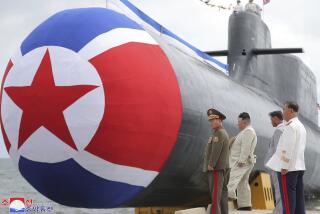German Submarines Ready to Dominate Arms Market
- Share via
KIEL, Germany — Das Boot is back.
German submarines, infamous for the terror they caused in two world wars, now are sinking competitors in the world arms market.
Preussag AG’s shipbuilding unit in Kiel, HDW AG, working as part of the German Submarine Consortium, is the front-runner for a $372-million submarine order from Thailand, beating competitors in Britain, Holland and Sweden.
HDW and the other members of the consortium, which includes Thyssen AG’s Thyssen Nordseewerke GmbH in Emden, Germany, are positioned to win orders from Asian countries that plan to build or expand submarines fleets in the coming decade, analysts say.
“HDW is by far the healthiest of all the yards,” said Richard Scott, editor of Jane’s Navy International, a defense industry journal. “I think commercially they’re very switched on. They know what the market’s looking for and they provide it.”
Even rivals acknowledge this.
“The Germans are very effective,” said Thomas Arosenius, a spokesman for Kockums Submarine Systems, a unit of Sweden’s Celsius Industries AB.
HDW, which stands for Howaldtswerke-Deutsche Werft, plays down its prospects. It points out that the Thai navy still has not officially made a decision which submarines to buy. It’s hard to tell whether other Asian countries will follow through on sub purchases, said Hans Seager, HDW’s director of naval sales.
HDW’s 1995 sales were 1.2 billion deutsche marks ($830 million), about the same as in previous years. The company speaks of “stability” rather than growth.
“We have a good chance to survive into the next century,” Seager said.
By the standards of the submarine industry, that would be an achievement. With the end of the Cold War, most Western nations cut back their submarine programs. There aren’t enough export customers to go around.
“In pure business terms, there isn’t enough work to keep all these yards going,” said Scott, the Jane’s editor. “Despite emerging requirements in the Far East, there isn’t going to be an explosion of orders.”
RDM Submarines BV, a unit of Royal Begemann Groep NV of the Netherlands, for example, has no outstanding orders. The company survives on refit work and is designing a new submarine called the Moray, which the Dutch navy might or might not buy.
RDM employs about 500 people, compared with 1,800 in the early 1980s, said Carel Prins, the company’s general manager for engineering, logistics and marketing. Begemann does not release separate sales figures for RDM.
Scott said RDM is in “real trouble.”
HDW, which also makes commercial vessels and naval surface ships, also has suffered. In 1972, the company employed 19,000 people and operated five shipyards, Seager said.
Today it has one shipyard, in Kiel, and 3,600 workers. The company plans to further cut the work force to 3,000, said Seager.
Analysts said the German Submarine Consortiums’s main competitor for the Thai order was Kockums, which in 1986 won a worldwide competition to help the Australian navy build a fleet of six submarines. A joint company set up to build the vessels in Australia has launched two so far.
However, Kockums has been accused of trying to bribe Thai officials. The company denies the accusation. Kockums’ Arosenius conceded the controversy will make it “difficult” for Kockums to win the contract.
U.S. shipyards build only nuclear submarines, which cannot be sold abroad, and are not competitors in the export market.
The Soviet Union was a major supplier of nonnuclear submarines, particularly to Syria and other client states that received “friendship prices.” Scott said Russia’s relatively unsophisticated submarines haven’t been able to compete in the world market.
About 40 countries, from Argentina to Iran, own submarines. A single submarine can threaten a large fleet--hence the appeal to countries that can’t afford a big surface fleet.
That is a big reason why Germany started building submarines in the first place. HDW’s yard in Kiel still has huge dry docks built around the turn of the century as part of plans to make Germany a sea power. German surface ships were outgunned by the British in both world wars. Only its submarines threatened Allied fleets.
An early submarine was built in Kiel in 1850. In World War II the shipyard, then known as Kriegsmarinewerft, produced more than 50 submarines.
Submarine production resumed in 1962 as the Germans rebuilt their military. Germany initially was forbidden by the victorious Allies to build submarines larger than 450 tons.
“That led us to think about getting a lot into a small space,” said Juergen Rohweder, an HDW spokesman.
German submarines today are the subcompacts of the submarine world, one reason for their popularity with smaller countries.
The first export customer was Greece, which bought four 209 models in 1971 and 1972. A modernized version of the 209 is still HDW’s workhorse. “It’s been around a long time,” Scott said. “It’s very quiet. It’s been continually updated.”
Germany is building submarines for South Korea and Israel. Indonesia and other countries already own German submarines, an incentive to trade up to more modern German models, Jane’s Scott said.
The German Submarine Consortium, which receives financial backing from MAN AG’s Ferrostaal AG unit, is hoping for a wave of refit business during the next decade as countries buy “air-independent propulsion” systems for their existing submarines.
“We are talking to several navies,” said George von Knoop, spokesman for Thyssen Nordseewerke.
The air-independent propulsion systems let submarines stay underwater for weeks, bringing their performance closer to that of nuclear submarines.
Other countries that might buy submarines fleets are Malaysia and Singapore, RDM’s Prins said.
“I even heard of the Philippines getting an interest, but I don’t know how serious that is,” Prins said.
As the shipbuilders compete in a dwindling market, Germany’s submarine history, as dramatized by the 1981 film “Das Boot,” is a selling point.
“Naturally, German submarines have a long tradition,” said HDW’s Rohweder. “They were especially effective in World War II.”
More to Read
Inside the business of entertainment
The Wide Shot brings you news, analysis and insights on everything from streaming wars to production — and what it all means for the future.
You may occasionally receive promotional content from the Los Angeles Times.










